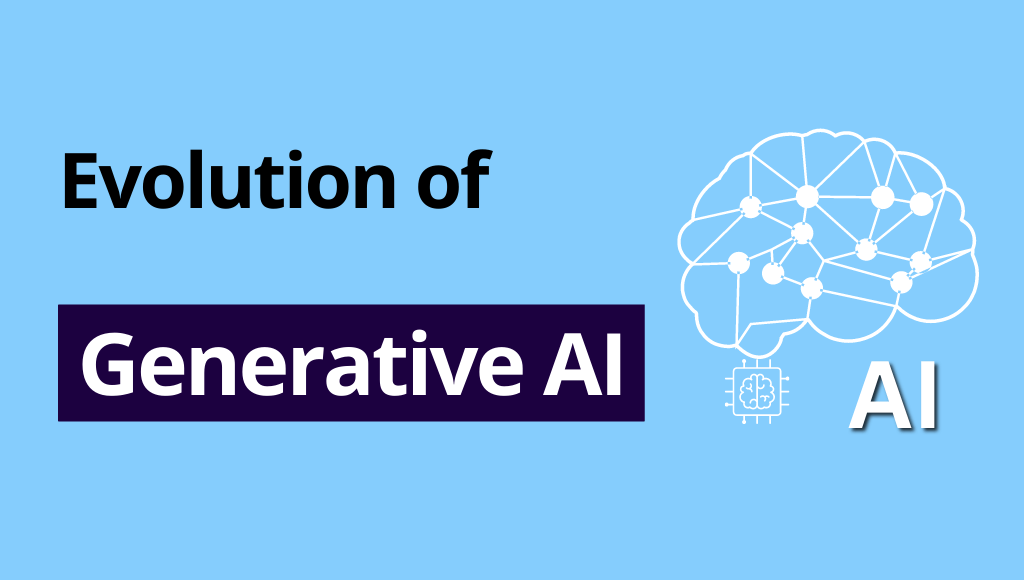Introduction
In a span of just a few decades, the landscape of artificial intelligence has undergone a transformative journey, particularly in the realm of generative AI. This field, which revolves around machines’ ability to generate content that ranges from images and music to text and more, has evolved from its rudimentary beginnings into a realm of astonishing creativity and innovation. The evolution of generative AI is a testament to the relentless pursuit of enhancing machines’ capacity to mimic, and sometimes even surpass, human creative processes. This narrative traces the remarkable trajectory of generative AI’s growth – from its humble origins to the dazzling feats it accomplishes today. Join us as we embark on a journey from the basic building blocks of generative AI to the brilliance that it manifests in the modern age.
Timeline of the Evolution of Generative AI
In the ever-evolving landscape of artificial intelligence, few branches have elicited as much fascination and curiosity as Generative AI. From its earliest conceptualizations to the awe-inspiring feats achieved in recent years, the journey of Generative AI has been nothing short of extraordinary.
- 1805: Long ago, in the year 1805, Adrien-Marie Legendre introduced a linear neural network (NN) with an input layer and a single output unit. This marked a foundation for shallow learning and more complex architectures.
- 1925: In the 1920s, physicists Ernst Ising and Wilhelm Lenz introduced the first non-learning recurrent neural network (RNN) architecture. This set the stage for the development of learning RNNs.
- 1943: In 1943, Warren McCulloch and Walter Pitts introduced the concept of Neural Networks, drawing inspiration from how biological neurons work.
- 1958: Frank Rosenblatt introduced Multi-Layer Perceptrons (MLPs) in 1958, an early form of deep learning.
- 1965: Alexey Ivakhnenko & Valentin Lapa introduced successful learning algorithms for deep MLPs with multiple hidden layers in 1965.
- 1967: Shun-Ichi Amari proposed training multilayer perceptrons (MLPs) using stochastic gradient descent (SGD) in 1967.
- 1972: Shun-Ichi Amari adapted the Lenz-Ising recurrent architecture to learn associations between input and output patterns, leading to the Hopfield Network.
- 1979: Kunihiko Fukushima introduced the first convolutional neural network (CNN) architecture in 1979.
- 1980: Autoencoders were introduced by Hinton and the PDP group in 1980 for unsupervised learning.
- 1986: Backpropagation, a key training method, was improved and introduced for neural networks.
- 1988: Wei Zhang applied backpropagation to train CNNs for image recognition.
- 1990: Generative Adversarial Networks (GANs) were proposed in 1990, involving two competing neural networks.
- 1991: Linearized self-attention, a precursor to Transformers, was introduced.
- 1995: The vanishing gradient problem in deep learning was identified.
- 1995: LeNet-5, a significant CNN, was introduced for digit recognition.
- 1997: Long Short-Term Memory (LSTM) architecture was published.
- 2001: Neural Probabilistic Language Model (NPLM) and LSTM’s language learning abilities were demonstrated.
- 2014: Variational Autoencoders (VAEs) were introduced for better training.
- 2014: Generative Adversarial Networks (GANs) framework was proposed.
- 2014: Gated Recurrent Unit (GRU) was introduced for capturing different time scale dependencies.
- 2015: Diffusion Models (DMs) for image generation became prominent.
- 2016: WaveNet, a model for audio generation, was introduced.
- 2017: Transformers architecture was introduced.
- 2018: GPT (Generative Pretraining Transformer) was introduced.
- 2018: BERT (Bidirectional Encoder Representations from Transformers) was introduced.
- 2019: StyleGAN introduced for generating images with attributes.
- 2020: wav2vec 2.0 for self-supervised speech representation learning.
- 2021: DALL·E introduced for generating images from text.
- 2022: Latent Diffusion models for image inpainting and generation.
- 2022: DALL·E 2 for generating images from text descriptions.
- 2022: Midjourney, a text-to-image model.
- 2022: Stable Diffusion for generating images.
- 2022: ChatGPT for interactive conversations.
- 2022: AudioLM for high-quality audio generation.
- 2023: GPT-4 for more accurate and creative responses.
- 2023: Falcon, a model for composing music.
- 2023: Bard, an AI for generating song lyrics.
- 2023: MusicGen, AI that composes music.
- 2023: AutoGPT for programming tasks.
- 2023: LongNet for summarizing lengthy texts.
- 2023: Voicebox for mimicking voices.
- 2023: LLaMA, a medical-focused language model.
- 2023: LLaMA2, second generation open source large language model by Meta
Conclusion
The evolution of Generative AI from its early stages to its current state of remarkable creativity showcases the remarkable progress achieved through innovation and collaboration. The journey highlights the potential of AI to transform various industries, open up new avenues of artistic expression, and offer tools to enhance human creativity and productivity. However, it’s crucial to approach this power responsibly, considering ethical implications and potential societal impacts.
The evolution of Generative AI is a testament to human ingenuity, pushing the boundaries of what machines can achieve creatively. As we look ahead, the future of Generative AI holds endless possibilities, promising a harmonious blend of machine and human creativity.


